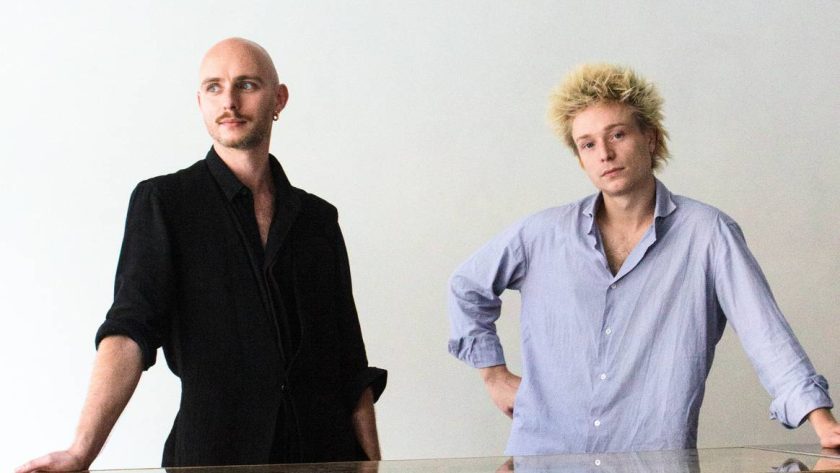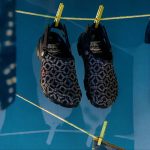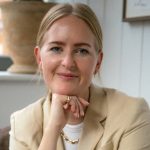Where can you find a really good fabric shop these days? From 22 September in Antwerp, at least. There, Bakermat has opened – a fabric shop, but also a material agency and, at a later date, it will even have a digital fabric library. “We want to fill a gap that is currently there in the transition from physical to digital material,” said Bakermat, and this is exactly what it will be about, explained founders Cedric Jacquemyn and Quinten Schaap to FashionUnited.
For those working in the fashion industry, it will be hard not to get excited about Bakermat. First of all, there is Bakermat’s physical location – the fabric shop. This shop features materials from manufacturers scattered around the world. The purpose of this physical hub is to show what materials are all available, but also to help young designers discover these fabrics and learn how to work with them. “We want to show that these techniques are out there and these people are still using them. Through the shop, young creators can now learn about these materials.”
Think selvedge denim from Japan, handwoven fabrics from India but also linen from Belgium and silk from Italy. For each material, there will be completely transparent communication about the production methods, where it comes from, etc.
Bakermat is fabric shop, material agency and digital textile archive in one
Bakermat offers a curated selection of materials. Curating involves several aspects. First of all ‘sustainability’, although Schaap and Jacquemyn don’t necessarily like the word. “What is qualitative and can be found within Europe is sourced within Europe. But what we go for outside Europe is, for example, selvedge denim in Japan. Or a jersey fabric made on vintage Japanese machines that you can’t find anywhere else. That just has to come from Japan. The hand-woven fabrics come from India, because hand weaving mills don’t exist in Europe anymore,” Jacquemyn said. “The selection process is structured in such a way, though, that we only go outside Europe if the techniques are important enough to bring back into Europe.”
Choosing handwoven fabrics, for example, is done by the duo because they want to keep a craft alive and preserve it. Offering these fabrics also supports a community in, say, India that makes the materials. Thirdly, Schaap and Jacquemyn also look at ‘future forward’ materials, such as fabrics with recycled elements. “The selection is a balance between heritage, handmade things and future forward,” they said.
Bakermat thus offers a wide range of materials. “We want to give everyone access to these materials,” he said. Indeed, as a young designer, it can be difficult to get in touch with manufacturers for specific fabrics. Beyond offering fabrics in the shop, Bakermat helps go the extra mile. For instance, the retailer is also a materials agency. “We work on a consultancy basis. We help anyone; designers, fashion companies, you name it, who come to us asking, ‘Hey, we’re working on this collection, we’re looking for this and this is our ideology as a company and what we stand for,'” Schaap explained. “Because we already have such an extensive archive in fabrics, we can more easily advise a customer which batches are interesting. That way, we want to make connections between the current industry, to help everyone take a step forward.” Schaap and Jacquemyn already have contacts with the manufacturers and can therefore move quickly. “We are a kind of intermediate step.” Often manufacturers want to cooperate, but don’t have time for all the requests. With this, Bakermat relieves the designers, but also the manufacturers.
Antwerp gets a ‘future forward fabric shop’
To go one step further and create a complete ecosystem, a digital library will also be launched this autumn. This means that all fabrics have been digitised to a format that can be used in digital design. As a result, all properties are immediately incorporated. “In digital design, people sometimes find 3D textures online and use them in the CAD programme. Then they find a texture for a 490g boiled wool and are happy with the designed item, but then have to find that fabric somewhere physically,” Schaap explained. “If you then want to switch from your virtual creation process to physical realisation process, there is a problem, because you have chosen a fabric that you picked from the internet.” When you switch fabrics, the fall of the fabric changes and the pattern pieces then have to be adjusted. “Otherwise, you get weird shapes.” So designing right away with the digital information of the physical fabric you can get from Bakermat has its advantages.
Access to the digital information of the fabrics sold by Bakermat will be through a subscription-based platform. An added advantage to the digital textile structures is that the moment a designer is happy with their digital design, they can order the fabrics directly from Bakermat’s webshop.
It is hard not to think of Bakermat as a textile Walhalla in Antwerp after talking to the two designers and entrepreneurs. “We want a fabric choice to be a conscious choice, not just an aesthetic choice,” he said.
This article was originally published on FashionUnited.NL. Translation and edit: Rachel Douglass.



